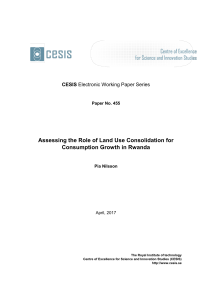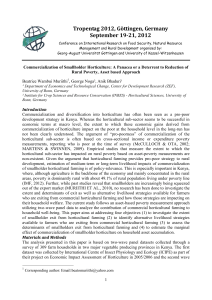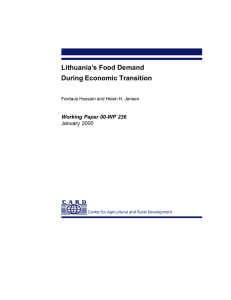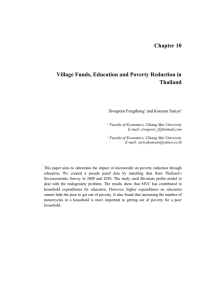The Determinants of Long-Term Growth in Smallholder
advertisement
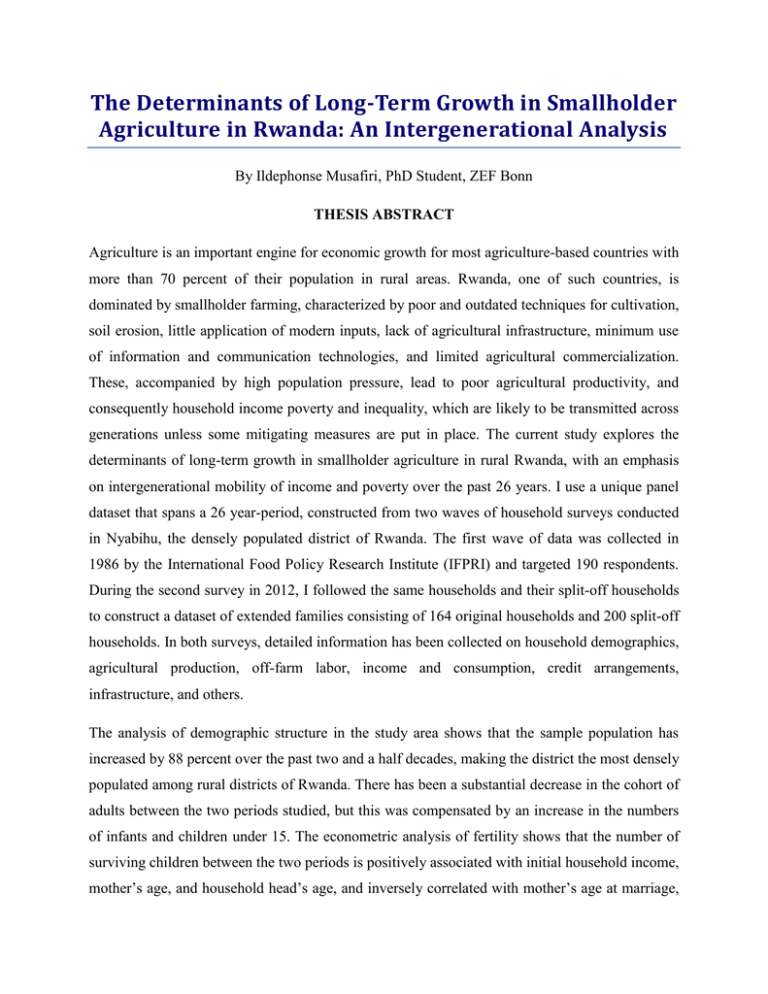
The Determinants of Long-Term Growth in Smallholder Agriculture in Rwanda: An Intergenerational Analysis By Ildephonse Musafiri, PhD Student, ZEF Bonn THESIS ABSTRACT Agriculture is an important engine for economic growth for most agriculture-based countries with more than 70 percent of their population in rural areas. Rwanda, one of such countries, is dominated by smallholder farming, characterized by poor and outdated techniques for cultivation, soil erosion, little application of modern inputs, lack of agricultural infrastructure, minimum use of information and communication technologies, and limited agricultural commercialization. These, accompanied by high population pressure, lead to poor agricultural productivity, and consequently household income poverty and inequality, which are likely to be transmitted across generations unless some mitigating measures are put in place. The current study explores the determinants of long-term growth in smallholder agriculture in rural Rwanda, with an emphasis on intergenerational mobility of income and poverty over the past 26 years. I use a unique panel dataset that spans a 26 year-period, constructed from two waves of household surveys conducted in Nyabihu, the densely populated district of Rwanda. The first wave of data was collected in 1986 by the International Food Policy Research Institute (IFPRI) and targeted 190 respondents. During the second survey in 2012, I followed the same households and their split-off households to construct a dataset of extended families consisting of 164 original households and 200 split-off households. In both surveys, detailed information has been collected on household demographics, agricultural production, off-farm labor, income and consumption, credit arrangements, infrastructure, and others. The analysis of demographic structure in the study area shows that the sample population has increased by 88 percent over the past two and a half decades, making the district the most densely populated among rural districts of Rwanda. There has been a substantial decrease in the cohort of adults between the two periods studied, but this was compensated by an increase in the numbers of infants and children under 15. The econometric analysis of fertility shows that the number of surviving children between the two periods is positively associated with initial household income, mother’s age, and household head’s age, and inversely correlated with mother’s age at marriage, and mother’s education. Other things being equal, wealthier households in 1986 have more children ever born and surviving children beyond 5 years in 2012. Within this population change scenario, I found an evidence for Boserup effect in the study area. There is a positive and statistically significant correlation between household size and agricultural intensification, farm productivity and household assets and expenditure. The agricultural production function in the study area is characterized by decreasing returns to scale. The fixed effects panel regression results (Cobb-Douglas function) suggest higher output elasticities of labor (0.48), followed by elasticities of capital (0.17) and land (0.13). Under land scarcity and population pressure environment, agriculture in the study area has become more labor intensive over time. However, the law of diminishing marginal returns to labor suggests a subsequent decrease in output levels in the near future if the population keeps its growth path without provisions to absorb the labor surplus outside the farm. Beyond the classical factors of production, an analysis of off-farm employment expansion and Information and Communication Technology adoption in agriculture is conducted. The study shows large increase in off-farm employment over time, principally resulting from high population growth. The use of cellular phones by rural farmers has significantly increased output and income levels in 2012. The Propensity Score Matching technique indicates that the level of agricultural output value is USD 89 (or 38 percent) higher for mobile phone users than for non-users. Similarly, the level of household income is USD 51 (or 26 percent) higher for mobile phone users. The transmission matrices and OLS regression results suggest a low income (expenditure) mobility and substantial persistence of assets across generations, especially in land and livestock. A 10 percent increase in parental landholding is associated with 3 percent higher land availability among the children. Similarly, a 10 percent increase in the parent’s livestock is associated with a 2.2 percent higher child’s livestock. A probit regression shows the persistence of poverty across generations. More than 57 percent of households were initially classified as poor in 1986. About 41 percent of offspring families are also poor in 2012. Despite the decrease in absolute poverty rate between the two periods of study to 40 percent for the whole sample, the increase in extreme poverty to 7 percent has resulted in high inequality among households.








